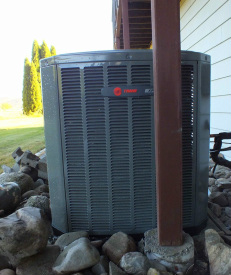Operation of the refrigeration system
Refrigeration systems contain high pressure gas, some of which can break down into poisonous gasses when heated. The voltages used are lethal. If you are not confident, call a professional
The refrigeration system must have 4 parts. A condenser, an evaporator, compressor and an expansion device.
Starting with the compressor, refrigerant gas is compressed to a higher pressure. After passing through the compressor, it passes to the condenser. The high pressure gas transfers its heat to the surrounding air and condenses. It then passes through the expansion device, which is a restriction separating the high side from the low side. After passing through the expansion device, the pressure is reduced because the compressor is removing gas from the end of the evaporator. This lowers the boiling temperature of the refrigerant. The lower temperature absorbs heat from the air passing over the evaporator and boils the liquid to a gas. The gas then passes into the compressor and the cycle repeats.
The video below is a representation of the refrigeration cycle.
Starting with the compressor, refrigerant gas is compressed to a higher pressure. After passing through the compressor, it passes to the condenser. The high pressure gas transfers its heat to the surrounding air and condenses. It then passes through the expansion device, which is a restriction separating the high side from the low side. After passing through the expansion device, the pressure is reduced because the compressor is removing gas from the end of the evaporator. This lowers the boiling temperature of the refrigerant. The lower temperature absorbs heat from the air passing over the evaporator and boils the liquid to a gas. The gas then passes into the compressor and the cycle repeats.
The video below is a representation of the refrigeration cycle.
For more on the refrigeration cycle, checkout the air conditioning design section

